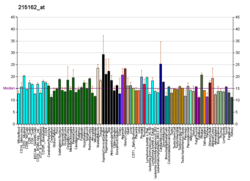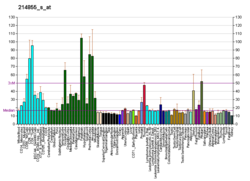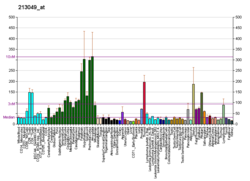| RALGAPA1 |
|---|
|
| Identifiers |
|---|
| Aliases | RALGAPA1, GARNL1, GRIPE, RalGAPalpha1, TULIP1, p240, Ral GTPase activating protein catalytic alpha subunit 1, Ral GTPase activating protein catalytic subunit alpha 1, NEDHRIT |
|---|
| External IDs | OMIM: 608884; MGI: 1931050; HomoloGene: 84805; GeneCards: RALGAPA1; OMA:RALGAPA1 - orthologs |
|---|
| Gene location (Human) |
|---|
 | | Chr. | Chromosome 14 (human)[1] |
|---|
| | Band | 14q13.2 | Start | 35,538,352 bp[1] |
|---|
| End | 35,809,304 bp[1] |
|---|
|
| Gene location (Mouse) |
|---|
 | | Chr. | Chromosome 12 (mouse)[2] |
|---|
| | Band | 12|12 C1 | Start | 55,602,896 bp[2] |
|---|
| End | 55,821,167 bp[2] |
|---|
|
| RNA expression pattern |
|---|
| Bgee | | Human | Mouse (ortholog) |
|---|
| Top expressed in | - endothelial cell
- Achilles tendon
- corpus callosum
- lateral nuclear group of thalamus
- sural nerve
- inferior olivary nucleus
- dorsal motor nucleus of vagus nerve
- Pars compacta
- Epithelium of choroid plexus
- external globus pallidus
|
| | Top expressed in | - ascending aorta
- visual cortex
- primary visual cortex
- aortic valve
- superior frontal gyrus
- cerebellar cortex
- primary motor cortex
- granulocyte
- medial dorsal nucleus
- mammillary body
|
| | More reference expression data |
|
|---|
| BioGPS | 

 | | More reference expression data |
|
|---|
|
| Gene ontology |
|---|
| Molecular function | - GTPase activator activity
- protein heterodimerization activity
| | Cellular component | | | Biological process | - regulation of small GTPase mediated signal transduction
- activation of GTPase activity
- positive regulation of GTPase activity
| | Sources:Amigo / QuickGO |
|
| Orthologs |
|---|
| Species | Human | Mouse |
|---|
| Entrez | | |
|---|
| Ensembl | | |
|---|
| UniProt | | |
|---|
| RefSeq (mRNA) | NM_001283043
NM_001283044
NM_014990
NM_194301
NM_001330075
|
|---|
NM_001346243
NM_001346245
NM_001346246
NM_001346247
NM_001346248
NM_001346249 |
| |
|---|
NM_001003719
NM_001112714
NM_001286263
NM_019994
NM_001368814 |
|
|---|
| RefSeq (protein) | NP_001269972
NP_001269973
NP_001317004
NP_001333172
NP_001333174
|
|---|
NP_001333175
NP_001333176
NP_001333177
NP_001333178
NP_055805
NP_919277 |
| |
|---|
NP_001003719
NP_001106185
NP_001273192
NP_064378
NP_001355743 |
|
|---|
| Location (UCSC) | Chr 14: 35.54 – 35.81 Mb | Chr 12: 55.6 – 55.82 Mb |
|---|
| PubMed search | [3] | [4] |
|---|
|
| Wikidata |
| View/Edit Human | View/Edit Mouse |
|



















